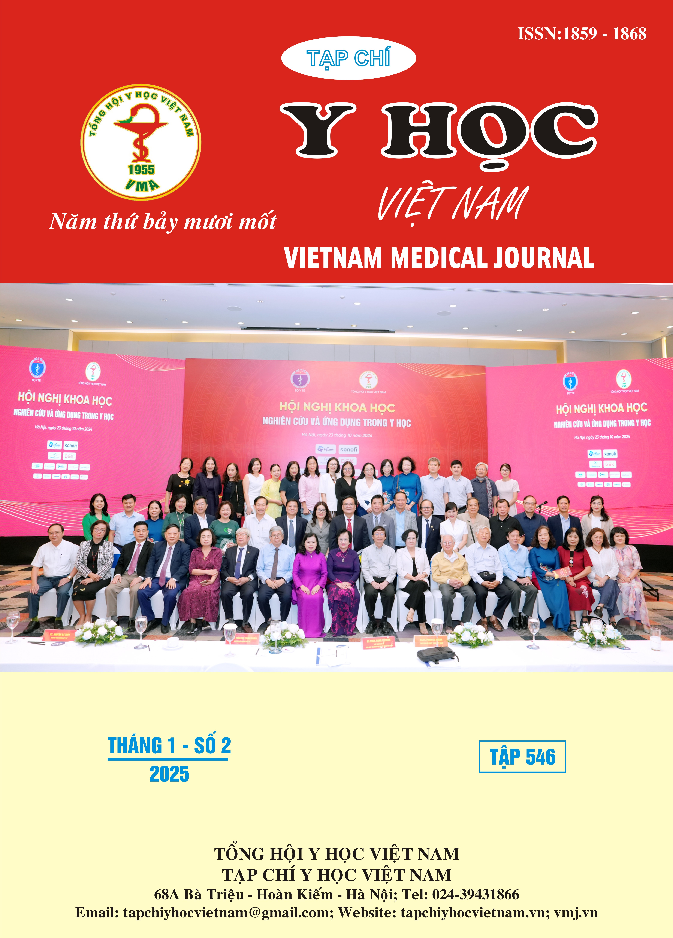CHARACTERISTICS OF MICROBIAL ETIOLOGIES OF VENTILATOR-ASSOCIATED PNEUMONIA IN THE DEPARTMENT OF INTENSIVE CARE AND POISON CONTROL – SAINT PAUL GENERAL HOSPITAL 2023–2024
Main Article Content
Abstract
Objective: Describe the characteristics of microbial etiologies of ventilator-associated pneumonia (VAP) in the Department of Intensive Care and Poison Control-Saint Paul General Hospital. Method: Cross-sectional, longitudinal study, data was collected on all mechanically ventilated patients in the department of Intensive Care and Poison Control – Saint Paul General Hospital from August 2023 to July 2024. Results: 73 patients were involved this study in which male/female ratio was 1,5, the mean age was 71,4 ± 14,4, the highest age was 98, the lowest age was 24. The prevalence of VAP was 47 cases/1000 ventilator-days, mostly of which are late-onset VAPs accounted for 54,1%. Repiratory cultures were appeared to be positive predominantly with 81,1%. Gram stain from a repiratory specimen with gram-negative bacilli mainly resulted in relatively Gram-negative bacteria in respiratory cultures. Common microbial etiologies of VAP were gram-negative bacteria, in which A.baumannii ranked first, followed by K.pneumoniae and P.aeruginosa. Common causes of late-onset VAP were A.baumannii alone or combination of two different gram-negative bacilli above. A.baumannii isolated were only susceptible to carbapenem, 3rd-generation cephalosporins, quinolon with less than 10%, intermediate to colistin with 88,2%. K.pneumoniae isolated were susceptible to carbapenem, 3rd-generation cephalosporins, quinolon with 20 – 30%, amikacin with 40%, fosfomycin with 60% and intermediate to colistin with 60%. P.aeruginosa isolated were susceptible to carbapenem, 3rd-generation cephalosporins, quinolon with 22,2 – 55,5%, intermediate to colistin with 88,9%. Conclusion: Common microbial etiologies of VAP were gram-negative bacteria, in which A.baumannii ranked first, followed by K.pneumoniae and P.aeruginosa. A.baumannii isolated were only susceptible to most of available antibiotics with less than 10%, intermediate to colistin with 88,2%. K.pneumoniae isolated were susceptible to carbapenem, 3rd-generation cephalosporins, quinolon with 20 – 30%, amikacin with 40%, fosfomycin with 60% and intermediate to colistin with 60%. P.aeruginosa isolated were susceptible to most of available antibiotics with 22,2 – 55,5%, intermediate to colistin with 88,9%.
Article Details
Keywords
VAP, microbial etiologies, antibiotic susceptibility
References
2. Hoàng Khánh Linh. Nghiên cứu đặc điểm viêm phổi liên quan thở máy tại khoa Hồi sức tích cực bệnh viện Bạch Mai giai đoạn 2017 - 2018. Luận văn chuyên khoa cấp II. Trường Đại học Y Hà Nội. 2018.
3. Nguyễn Đức Quỳnh (2020). Một số đặc điểm kháng kháng sinh và yếu tố nguy cơ nhiễm khuẩn bệnh viện do Klebsiella pneumoniae kháng carbapenem tại Khoa Hồi sức tích cực – Bệnh viện Bạch Mai (7/2019 – 8/2020). Y dược lâm sàng 108, tập 15 (7): 82 – 88.
4. National Healthcare Safety Network. Pneumonia (Ventilator-associated [VAP] and non-ventilator associated Pneumonia [PNEU]) Event. January 2023.
5. Nguyễn Kim Thư (2023). Căn nguyên vi khuẩn gây viêm phổi liên quan thở máy trên bệnh nhân điều trị tại bệnh viện Đại học Y Hà Nội. Y học Việt Nam, 525(1B): 289-293.
7. Trần Thị Hải Ninh. Nghiên cứu căn nguyên, kết quả điều trị và xác định đường lây truyền của các vi khuẩn đa kháng thuốc gây viêm phổi liên quan đến thở máy bằng kỹ thuật giải trình tự gen thế hệ mới. Luận án tiến sỹ y học. Đại học Y Hà Nội. 2021
8. Phạm Hồng Nhung (2023). Nhiễm trùng do các trực khuẩn Gram âm thường gặp tại Trung tâm Hồi sức tích cực Bệnh viện Bạch Mai năm 2023. Nghiên cứu Y học, 178(5): 43 – 50.
9. Nguyễn Đức Phúc (2023). Đánh giá mức độ kháng kháng sinh của các chủng vi khuẩn gây viêm phổi liên quan thở máy xâm nhập tại bệnh viện hữu nghị đa khoa Nghệ An. Truyền nhiễm Việt Nam, 1(45): 33-39.


